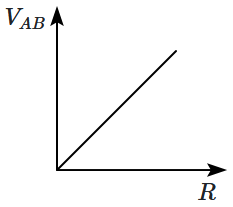All the resistances in circuit are \(2~\Omega\) each, \(E_1=4~\text{V}\) and \(E_2=1~\text{V}\). The potential difference between \(C\) and \(D\) (i.e. \(V_{C}-V_{D}\)) is:

1.
\(1.5~\text{V}\)
2.
\(-1.5~\text{V}\)
3.
\(1.2~\text{V}\)
4.
\(-1.2~\text{V}\)

To unlock all the explanations of this course, you need to be enrolled.

To unlock all the explanations of this course, you need to be enrolled.

| 1. | equals \(400~\Omega.\) |
| 2. | equals \(200~\Omega.\) |
| 3. | can have any value less than \(400~\Omega.\) |
| 4. | cannot be determined from the given information. |

To unlock all the explanations of this course, you need to be enrolled.

To unlock all the explanations of this course, you need to be enrolled.

| 1. | \(V=2\) volts, positive at \(A.\) |
| 2. | \(V=2\) volts, negative at \(A.\) |
| 3. | \(V=6\) volts, positive at \(A.\) |
| 4. | \(V=6\) volts, negative at \(A.\) |

To unlock all the explanations of this course, you need to be enrolled.

To unlock all the explanations of this course, you need to be enrolled.

| 1. | \(4~\Omega\) | 2. | \(2~\Omega\) |
| 3. | \(\dfrac43~\Omega\) | 4. | \(\dfrac{10}3~\Omega\) |

To unlock all the explanations of this course, you need to be enrolled.

To unlock all the explanations of this course, you need to be enrolled.

| 1. |  |
2. |  |
| 3. |  |
4. |  |

To unlock all the explanations of this course, you need to be enrolled.

To unlock all the explanations of this course, you need to be enrolled.

| 1. | \(1~\text A\) | 2. | \(0.5~\text A\) |
| 3. | \(2.5~\text A\) | 4. | \(3~\text A\) |

To unlock all the explanations of this course, you need to be enrolled.

To unlock all the explanations of this course, you need to be enrolled.
| 1. | \(2~\Omega\) | 2. | \(4~\Omega\) |
| 3. | \(6~\Omega\) | 4. | \(1.6~\Omega\) |

To unlock all the explanations of this course, you need to be enrolled.

To unlock all the explanations of this course, you need to be enrolled.
1. \(1\)
2. \(\dfrac12\)
3. \(\dfrac21\)
4. \(\sqrt2\)

To unlock all the explanations of this course, you need to be enrolled.

To unlock all the explanations of this course, you need to be enrolled.

1. \(2 ~\Omega\)
2. \(3.2 ~\Omega\)
3. \(4 ~\Omega\)
4. \(6.4 ~\Omega\)

To unlock all the explanations of this course, you need to be enrolled.

To unlock all the explanations of this course, you need to be enrolled.

| 1. | \(\dfrac{I}{A}\) | 2. | \(\dfrac{I}{A}~\cos30^\circ\) |
| 3. | \(\dfrac{2I}{A}\) | 4. | \(\dfrac{I}{A}~\sin30^\circ\) |

To unlock all the explanations of this course, you need to be enrolled.

To unlock all the explanations of this course, you need to be enrolled.






